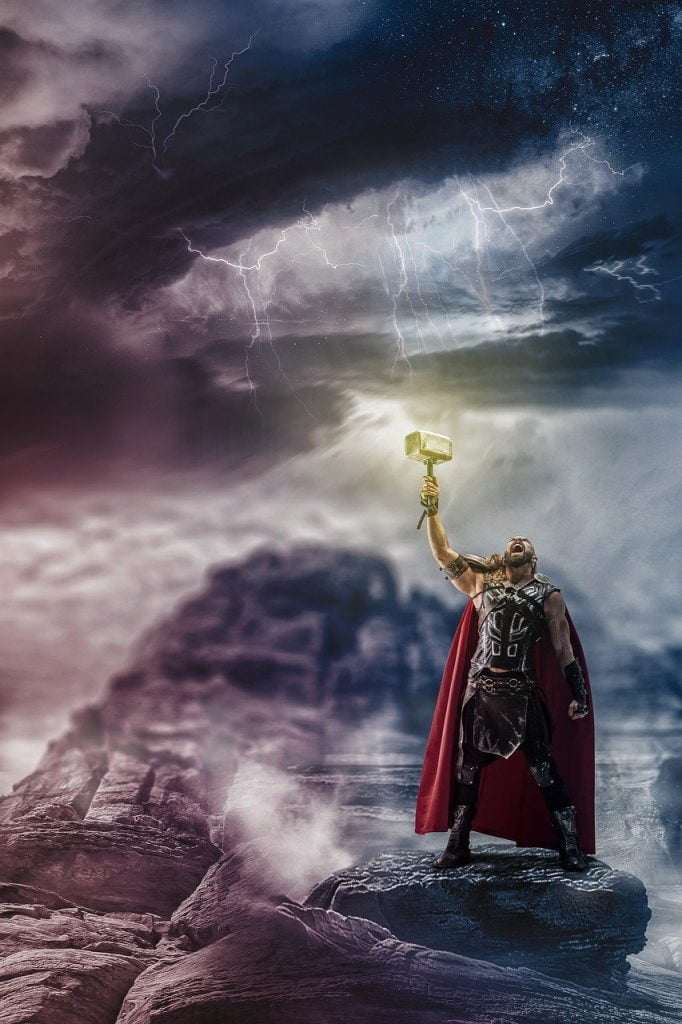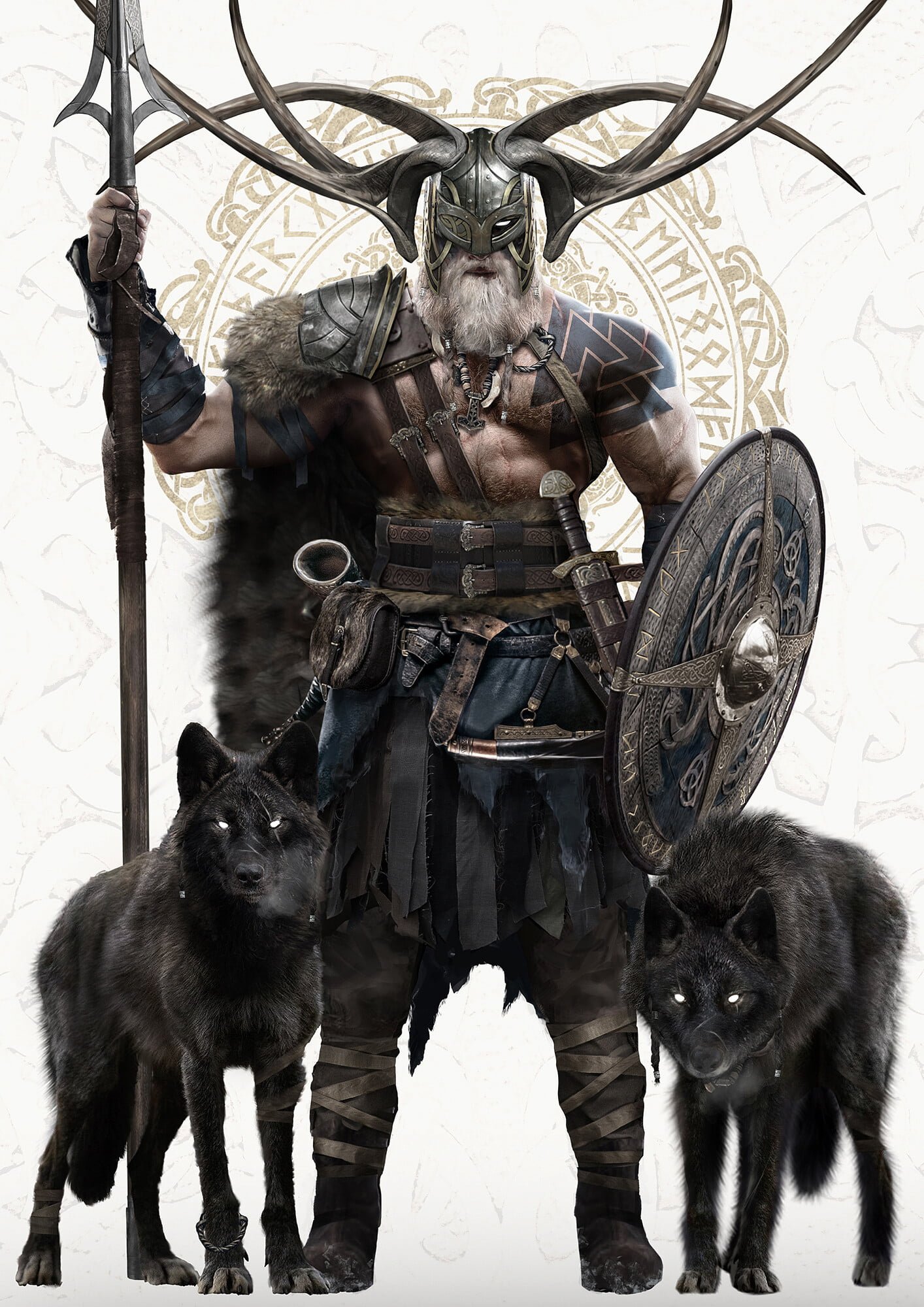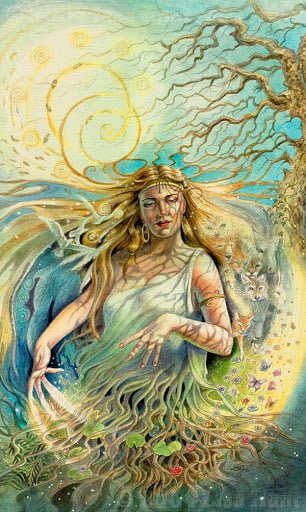Aesir Goddesses, Aesir Gods, Norse Goddesses, Norse Gods, Norse Mythology, Tales of the Gods, Thor, Thrúd
THOR: THE NORSE GOD
Who Is Thor?
Today we were lucky enough to take a closer look at the mythology of Scandinavia and dwell on one of the most important Viking god Thor. Well, let’s start with the first question that is most always ask what kind of god is Thor?
Thor god of thunder – occupies an honorable second place in the Scandinavian divine pantheon. Thor is the son of Odin and the earth goddess Erd, he represents strength (either brute physical strength or subtle strength, say, willpower) because strength was the main virtue of the Vikings.
Thor the Thunderer is a strongman with a huge hammer “Melnir”, with its help he can send thunder and lightning, with this weapon in his hands Thor constantly fights with numerous giants, who now and then want to capture the abode of the gods Asgard. The cult of Thor was very popular in Scandinavia, and its symbols – Thor’s hammers are often found in Scandinavian countries during archaeological excavations.
Thor travels in a chariot pulled by goats with his servant and messenger Tjelvar. Edda notes that the scorched earth was left behind the chariot, and the mountains crumbled and cracked behind it. When Thor was hungry, he roasted goats and ate them. To continue his journey, all he had to do was touch the remains of the goats, and they were instantly fully restored, ready to drive the chariot onward.
Thor wields the battle hammer Mjolnir, which, when thrown at its target, magically returns to its owner. To use such a powerful weapon, even a god-like Thor requires special iron gauntlets and a belt, doubling the wielder’s strength.
The blow of the hammer causes thunder; with it, Thor enjoyed the joys of his favorite hobby: killing giants.
It is also very often asked about the god of war Thor. But this question does not have a clear answer, because he either fought because he hated giants, but also was very good.
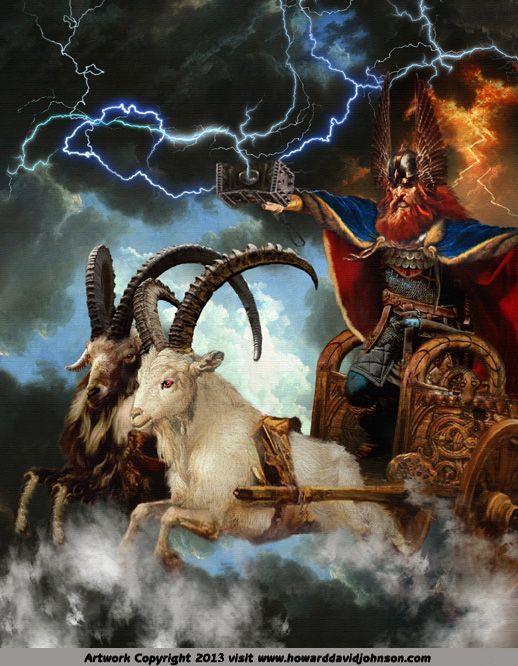
Where Is Thor From?
Thor is the child of the union of Odin, lord of Asgard, and Gaia, goddess of Midgard (Earth). Thor was born in a Norse cave, from where Odin took him to Asgard to be raised. Thor spent his childhood with his adopted brother Loki, who was constantly jealous of him and eventually plotted to kill his brother. Thus began their centuries-long feud.
Thor’s Dwelling in Heaven – Trondheim
In ancient Norse mythology, Trondheim is the residence of Thor, the son of Odin. It is mentioned in the “Grimnir’s Speeches” of the “Elder Edda”. In Old Norse, Trondheim (“Þrúðheimr”) is translated as “land of strength”, although many online sources often give the wrong translation “house of strength” for some unknown reason. Trudvang (“Þrúðvangr”) means “field of strength.”
There is no description of Trudheim in any Eddic text, but in the “Vision of Gulvi” this place is called a kingdom, and it is said to contain the hall of Bilskirnir. From the ancient Scandinavian “Bilskirnir” translates as “the rattle of lightning.”
Based on lines from Grimnir’s Speeches, E. Orchard assumes that Trudheim is also located in Asgard. This is a legitimate assumption, which, however, can be confirmed by a single circumstantial indication. There is no further information about Trudheim, Trudwang, or Bilskirnir in the Eddic texts.
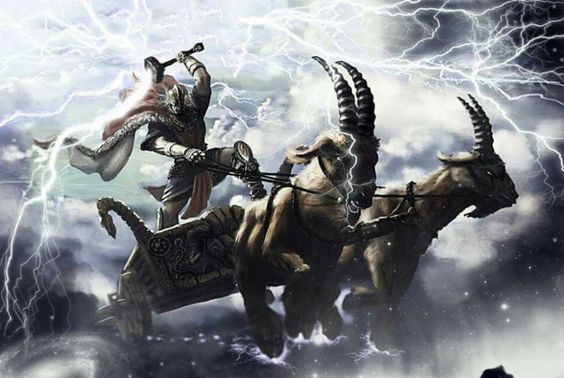
What Is Thor The God Of?
Thor in Germanic-Scandinavian mythology, the god of thunder, fertility, protects the gods and people from the giants and other evil forces. In the European territories of the Germanic tribes, he was dedicated the same day of the week, in Rome – to Jupiter. However, unlike other gods-thunderer, Thor is not the full head of the pantheon of Germanic-Scandinavian deities, because a number of his functions in the mythology have taken over Odin and Tiu (Tür).
Thor, in Scandinavian mythology, has the nicknames Veorov, Vingnir, Chlorridi.
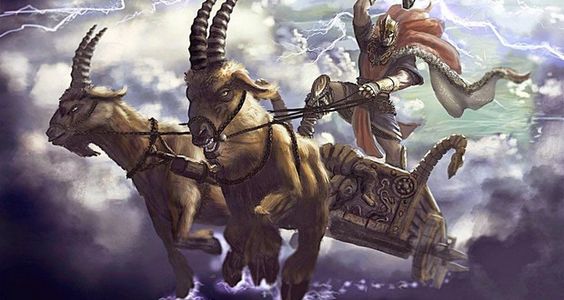
Thor’s Role In The Viking Age Social World
The culture of Norway, Iceland, and Germany are simply impossible to imagine now without mythology, which was the main religious belief of these peoples. According to the pagan cult, almost every natural phenomenon had its god or goddess, but the geographic location of the Nordic countries had a significant impact on the nature of the gods of the Scandinavian pantheon.
The long cold winters and harsh summers did not dispose of a kind and lovable deities, so the latter tended to be stern warriors, fighting for good and peace in heaven and on earth every second of their existence. Most of these deities were benevolent to people and helped them out of trouble, but the weak and cowardly deities were severely punished. After all, in a harsh climate, there is no room for weakness and regret.
It is not surprising that the most incomprehensible and terrible natural phenomena were easily explained to the Scandinavians by mythology. Thor Viking god, for example, was the god who could cause thunder and lightning, but he used them only against the giants, protecting the human world and the fortress of Asgard from them. That is why Tor was loved and revered by all, his feats piled up a lot of funny and instructive stories, which can be imagined by what incredible qualities endowed obstinate ace people.
It is worth noting that ordinary people treated the magic hammer of the thunder with great reverence and often used his image as a talisman. Archaeologists have found many pendants in the form of a hammer covered with patterns and runes at ancient temples. Most often amulets were made of iron, which was considered Thor’s metal, and silver, reminiscent of the glitter of lightning in the night sky.
Thor, the Scandinavian god, also represented the masculine principle. As such, he was called upon to make the earth fruitful and to give birth to babies.
Babies always had a small hammer on a waxed cord around their necks, often done at the same time as the naming of the newborn. The hammer was used at weddings and was also placed on the funeral pyre of a warrior.
During the construction of houses, peasants hammered into the bounding posts and blessed the threshold of their homes with it so that no evil and dark forces could penetrate into a person’s life.
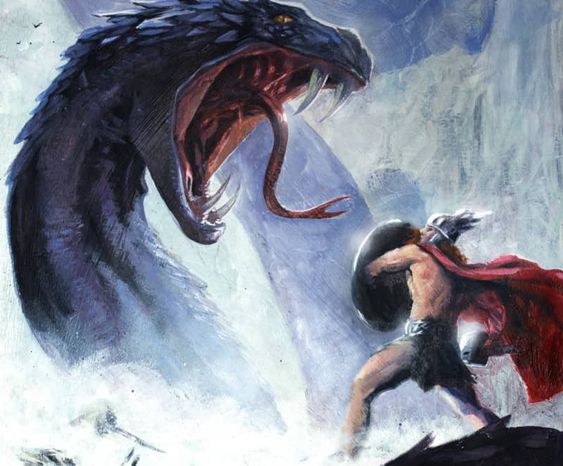
Powers & Duties Of Thor
Thor was responsible for the weather, crops, and sea voyages. The ancient Scandinavian rune Turisaz contains the power of the god Thor. Curiously, the thunder during a storm did not cause fear among the Vikings and was considered a sign that Thor was performing his duties – that is, killing the ice giants.
Legends And Stories Of Thor
Viking mythology was created in the 5th century B.C. before the adoption of Christianity by the Scandinavian peoples. The main source about it is the texts of the ancient epic “Elder Edda” as well as the “Edda” of S. Sturluson. When we are going to read Scandinavian myths, sagas, and legends to our children, we are telling them about the former times of the harsh Nordic peoples and their ideas about the world, good and evil, and the order of things on earth.
All the life-giving juices of Mother Earth Thor absorbed into himself, all the power of the elements and impetuosity he took from his father, the God of heaven. He gave rain and fertility to the field, awoke dormant flowers and trees in spring thunderstorms, and helped migratory birds.
But most of all Thor cared about people; he guarded Mitgard against giants and monsters, almost constantly battling them in the far and cold east – otherwise, their kind would have grown, filled with itself all, like a weed, leaving no place for anyone.
And the gods considered Thor the chief guardian of Asgard. As soon as his name was uttered in a loud voice, the god of thunder appeared and without delay engaged in battle with the most terrible enemy.
They say that at ten years old Thor began carrying his father’s weapons, at twelve he was so strong that he could lift ten heavy bears’ skins from the ground at once. As a gift from the giantess Grid, one of Odin’s wives, he received the Belt of Power; when you put it on, the fortress becomes twice as strong. And when the Carls presented Thor with the hammer Mjollnir (this gift will be discussed later), he became invincible at all.
Because the hammer could instantly kill, split in two the skull of even a mountain giant, split the mightiest tree, to drive anyone knee-deep in the ground. I had only to order iron gauntlets, otherwise, I could not hold, could not throw a miracle hammer.
Another legend has it that the giantess gave Thor and the staff. After all, wherever Thor was, wherever he went. Had to overcome boulders and rocks on the way, to wade through the thickets, to swim across the stream. No horse could ride where Thor rode, only the horse’s shoes would be broken, and his breath would catch fire. And so Thor preferred two fast-footed goats. One was named Tangrisnir, “Grinding Teeth,” and the other was named Tangiostr, “Squeaking Teeth”. One could hear in these names the howling of the wind and the creaking of the trees, the storm and the hurricane. The goats might fall dead in the evening, but in the morning their master would sanctify them with his hammer, and again they would gallop tirelessly.
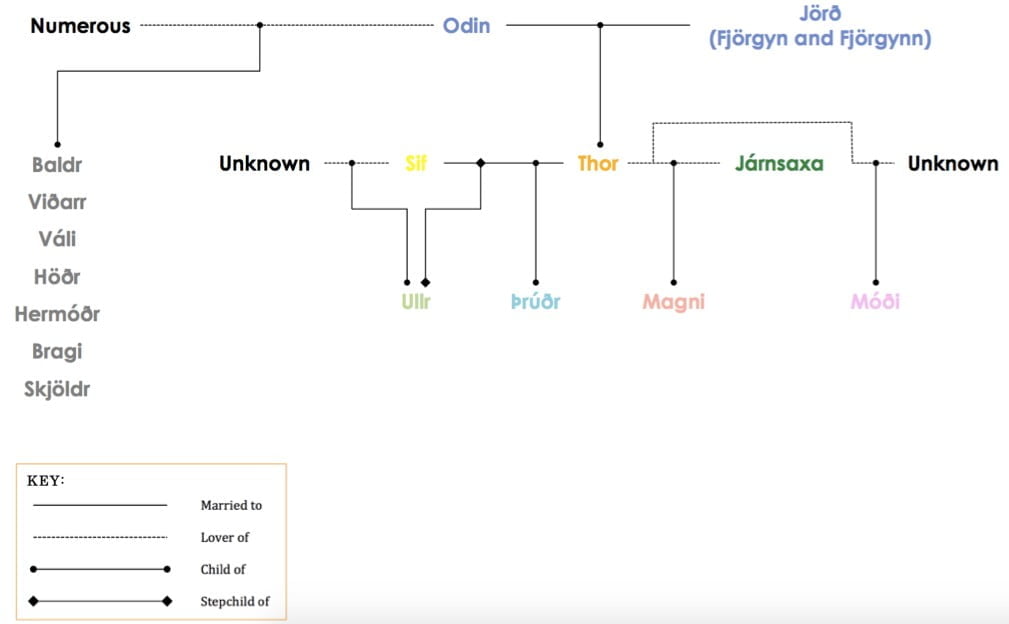
Thor’s Family Tree
Scandinavian mythology has become the symbolic basis for the formation of many religious and ethical teachings that have appeared on earth in the last two thousand years, including the Christian tradition. These are the chthonic monsters opposed to the gods (Fenrir the wolf, Ermingard the serpent, Hel the mistress of the kingdom of the dead, Garm the dog) and the eturns (giants), as well as the zwerg (dwarf smiths who live under the ground or in stones), Alves (inferior natural spirits), Norns (female spirits who determine the fate of all humans at birth), Valkyries (warlike female spirits, servants of Odin) and Eutherians (dead heroes who dwell in Valhalla). For example, the analogy between Thor in her arms and Isis with Horus in her arms is obvious. The Aesir lord considers Fulla her sworn sister and trusts her with her most secret thoughts.
And Idunn’s abduction and her return to the gods is thanks to Loki (for an account of the myth, see also the Iron Forest and the Stone Mountains located there. – But you are no better than any of us. In modern occult practice, Thor is more often called upon for help in legal proceedings. The myth recounting this has been lost, but it probably explained how Heimdalll acquired his finest hearing (for Odin, too, sacrificed one eye and became omniscient). Einheria – the fallen warriors taken into the retinue of the god Odin.
Frigg is the first of a series of goddesses. The image of this goddess is very tragic. We do not find an answer to this question in the Eddas. Secondly, he was the patron of wisdom, poetry, and war. She is the giver of life and death, while Frigg gives only life. – I’m not going anywhere,” the fire god said as he sat down at the table.
Hrimfaxi, the horse in Mani’s chariot, carries the moon. Modern thought is embodied in these two major deities, whose influence is complementary rather than hierarchical or antagonistic.
Igg is one of Odin’s heiti. On the raging waves of this worldwide flood the terrifying ship Naglfar, made of the nails of the dead, will sail out of Helheim (alternatively, it will ride out on ice frozen over three years of winter, in the manner of a giant sled). Embla is the first woman on earth made of willow (other reports say alder) by the Aesir. When do Freia leaves, she seeks him out in all nine worlds, taking various names: Mardoll (“shining like the sea”), Sur (“pig”), and Gewon (“giver”). Thor, on the other hand, was presented as the patron of the working classes – the bondes (free farmers) and slaves.
Afterward, Odin, Thor’s mother, and Thor himself were sewn. The genealogical or genetic tree also includes Thor’s wife and his children. Therefore, these divine beings are considered the most important in the Thor family tree.
Thor’s Father
And now we turn to the question of who is the father of Thor.
Odin or Wotan, Wodan (“all-father”, “warrior”), the supreme god of Nordic-Germanic mythology, son of Bor and Bestla, grandson of Storm. His cult was especially popular with the Vikings, and thus the period of his heyday was in the eighth and ninth centuries. Seafarers and pirates of the North worshiped 6ogy who loved battles and believed that in Valhalla, Odin’s silver-roofed dwelling, this one-eyed god gathered a host of Einherians, “valiant fallen” warriors.
Odin is often depicted as a one-eyed, gray-bearded old man in a blue cloak whose face is concealed by a hood or broad-brimmed hat. The god gave his eye to Mimir, the owner of the source of great wisdom, for a single sip from it. The remaining eye symbolized the sun, and the lost eye, the symbol of the moon, floated in Mimir’s spring. To learn the mystery of the dead and gain the gift of clairvoyance, Odin, pierced with his spear, hung nine days on the world tree Yggdrasil. Then, after quenching his thirst with sacred honey, he received from the giant Bölthorn, his maternal grandfather, the magical runes – the carriers of wisdom.
Odin had a wife, Frigg, who lived in Asgard. Odin’s sons were thought to be Thor, Baldr, Hed, and Vali, among others.
Thor’s Mother
Thor’s mother’s name is Jord (also Yord). A woman of the giants, known for being the mother of Thor, but not for being Odin’s wife.
Who is Thor’s mother in Norse mythology?
She was supposedly worshipped as the goddess incarnate of the earth. In skaldic poetry, Jord is mentioned quite often, in most cases, as kenning Thor.
Coming back to Jord, it is worth mentioning that the original Old Norse word “Jörð” is also present in an identical or slightly changed form in other Nordic languages, for example, “Jörð” in Icelandic, “Jørð” in Faroese, “Jord” in Danish, Swedish and Norwegian. Presumably, the modern English word “earth” also goes back to the Old Norse “Jörð” through the Old English form “eorðe”. All of these word forms have one translation, “earth.” In Snorri Sturluson’s “Vision of Gulvi” from the Younger Edda, Jord is mentioned as a woman of Odin, but not as his wife. It also says that Jord is Thor’s mother, she is a Jotun, the daughter of Annath and Nyött (nothing is known about Annath, and Nyött is the personification of the night in ancient Norse mythology). Jord has two sisters, Audr (“Auðr” translated “prosperity”) and Dagr (“Dagr” translated “day”).
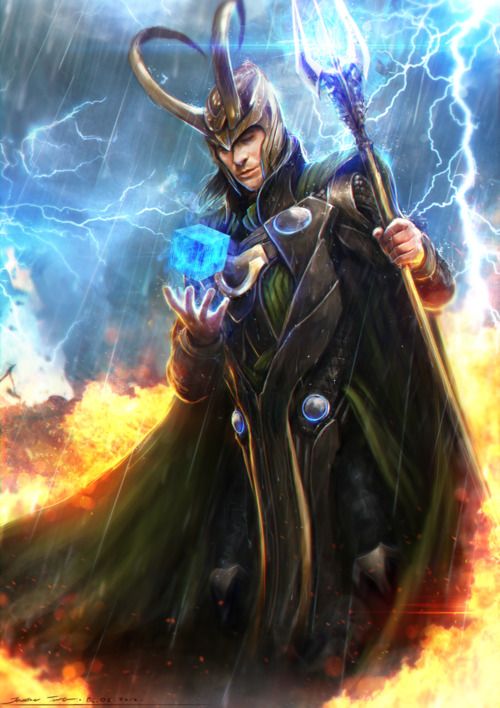
Thor’s Brother
The most controversial character of Scandinavian mythology. The great source of problems in all nine worlds.
Loki is the god of fire and cunning. One of the main characters of Scandinavian mythology.
He is considered the main villain. Also, he is the most popular god. Loki is involved in almost all the myths of medieval Scandinavia.
His parents are the giant Farbauti and the goddess Lauveia.
Loki is not Odin’s adopted son, but his named brother. They are bound together by an ancient rite of brotherhood. Also, people considered Loki the brother of Thor.
After numerous acts in various myths and stories, Loki sets up the murder of Odin’s son Baldr. As punishment for this murder, the gods handcuff Loki to a cave deep underground for life.
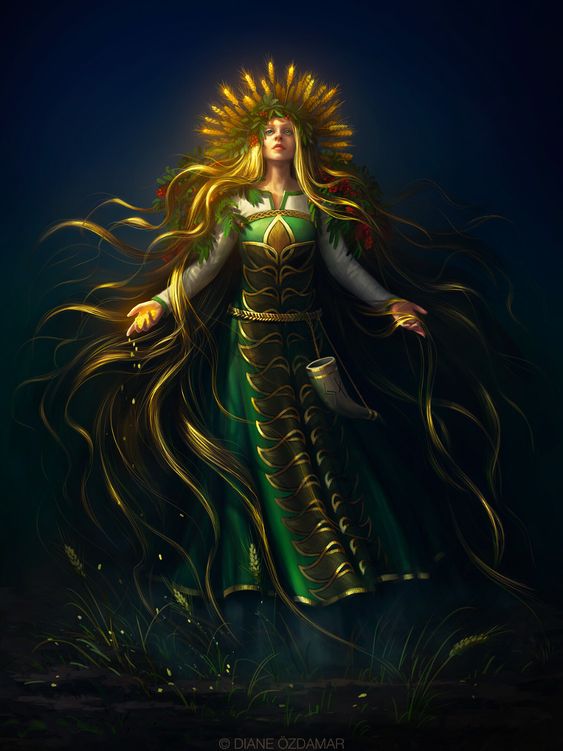
Thor’s Wife
Sif in Scandinavian mythology is a goddess, wife of Thor. From her first marriage, she had a son Uu, the god of archers and skiers. Sif was famous for her amazing golden hair (apparently a symbol of fertility). She was the one, who was the wife of Thor and goddess of the harvest.
There is a myth about how Loki cut off her hair, and then, at Thor’s demand, he made the Zwerg forge for Sif a magic wig of golden threads, which looked wonderful: even the faintest breeze fluttered the thick golden strands, and, in addition, the hair itself grew on her head.
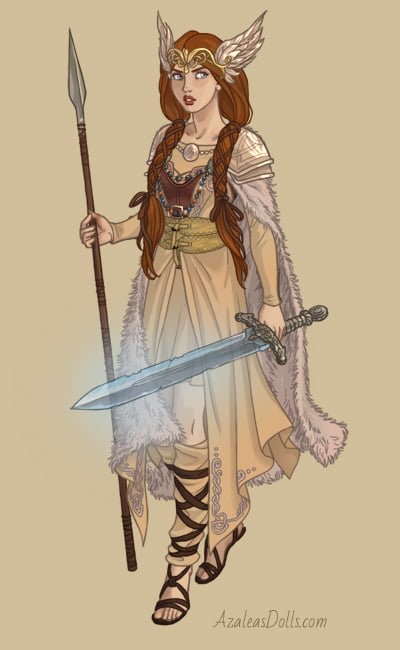
Thor’s Daughter
The first question can be who did Thor have a daughter with?
Thrud (Þrúðr) or Torunn daughter of Thor and Sif. Her name means “Strength.” Nevertheless, we in Skarsgaard believe in much more than that. Thrud is often seen as a tall, strong woman whose hair is pulled back, but still not in disarray. Her clothes are usually ragged and disheveled; as a laborer, she is too busy to pay attention to her condition.
Because of her strength, she is like a giantess. The rocks and stones that are sacred to her are those turned out by the plow.
Other colors that are associated with Thrud are bright red and gold.
This goddess also appears as one of the main characters in the fascinating work of pagan enlightenment literature.
Thor Symbols
On the subject of what symbols Thor had, it was Mölnir, his hammer, his goat-driven chariot, his helmet, his iron gauntlets, and his belt.
Mjolnir is a stunning, spectacular weapon, with which you can easily arrange your own Ragnarok in a single world, but without gloves and belt, it is like an iPhone without a branded charger. It will work, but half-heartedly and reluctantly.
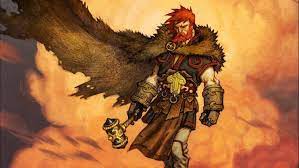
Mjolnir – Thor’s Hammer
Thor’s hammer amulet is a powerful amulet that can not only protect its owner but also endow him with various abilities. This Scandinavian talisman belongs to one of the strongest deities from Scandinavian mythology. Also, Thor’s hammer name is Mjolnir.
The talisman is considered light and provides help to all who need it. Despite this, the use of the talisman should be extremely careful. There are several nuances, non-compliance with which will cause unpredictable consequences, about which we will tell below.
Scandinavian mythology has much in common with the religions of other peoples, including the Slavs. For example, the Slavic god Perun is considered the “brother” of Thor. Nevertheless, their weapons, the hammer and the ax have very different histories of origin.
Perun’s ax appeared during the deity’s battle with a monster, but Mjolnier was presented to Thor as a gift. One of the legends says that this weapon was made especially for the god of war and victory. The hammer of Thor was forged by dwarves, gnomes, or doves, as the Scandinavians themselves called them.
It was believed that dwarfs were the best craftsmen in the world, and no one could compare to them.
Dwarves not only made weapons of the most flexible and strongest steel – they were able to masterfully create such small things that humans could not physically see.
Many legends, dwarfs often made weapons for those who could elicit their sympathy and approval. The things created by the dwarves were believed to have amazing properties. Mjolnir is no exception – it always returned to its owner, no matter how far it was thrown.
Thor’s hammer was a unique weapon that obeyed only its master. No one could lift Mielnir but Thor.
In addition to its incredible ability to return to its owner, the weapon was incredibly heavy. Myths say that Thor’s hammer could pierce a giant’s head with a single blow.
When the dwarves were busy making the hammer, Loki, the god of cunning and deception, tried to stop them. He turned into a fly and constantly distracted the dwarves from their work. As a result of his manipulations, the Mielnir turned out to be a bit flawed. The handle of the weapon was too short, which shifted the center of gravity. It was thought to be difficult even for Thor to lift the hammer, but with his strength, he used the weapon successfully in battle.
The hammer often served Thor as a kind of boomerang that swept away everything in its path.
The myths also mention that the god wore special metal gloves in battle. There is no exact explanation – in the myths, there are all sorts of versions. According to one, it was easier for the deity to lift the hammer when wearing mittens.
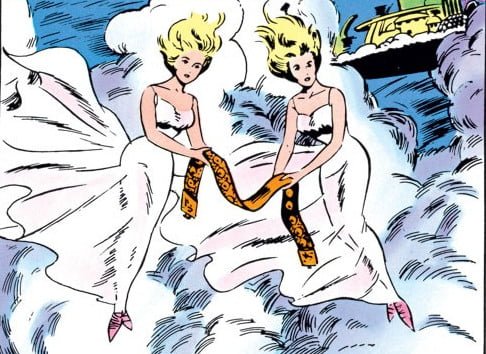
Meginjord – Thor’s Belt Of Strength
Thor used the belt to accumulate the power of Thor’s gauntlets, to move truly huge and heavy objects. Thor’s magical Belt of Power doubles his bodily power and iron gauntlets.
In ancient times, the treacherous god Loki lured Thor into the domain of the evil and cruel leader of the giants Geirröd. Before the upcoming battle, the god of thunder stopped for the night at the giant Grid. Grid treated Thor well. She fed him with the roast bull, gave him glorious honey, and made his bed. Early in the morning, the giantess woke Thor and helped him get ready for battle.
“Geirröd is strong and cunning, be careful of him,” said the giantess, pulling out a large ancient chest from under the bed and beginning to look for something in it.
“Here. This will help you,” and Thor saw good-quality metal gauntlets and a large wide belt decorated with runes.
Thor accepted Grid’s gifts and got dressed. Felt thundered how the gauntlets firmly held a weapon. And from the belt comes a lot of power.
Thor defeated the evil giant Geirröd. So he was left with magic mittens and a belt of power, after that battle. And the giantess Grid became a good friend to all the aces.
Jarngreipr – Thor’s Iron Gloves
Thor had his magic mittens. According to the legend, the magic mittens make the hammer glow red-hot. And they are made of pure iron.
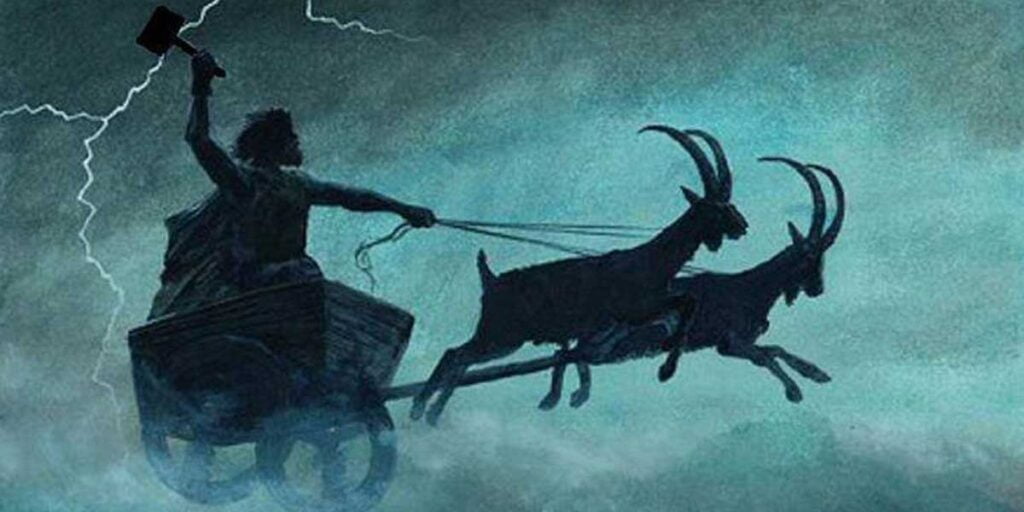
Goats: The Servants Of Thor
Tanngnjostr and Tanngrisnir. That was the name of our heroes. The two goats didn’t just pull Thor’s chariot behind him, they gave him constant sustenance. Guess how? Exactly. They sacrificed themselves every night just to get Thor fed (there’s some doubt, but that’s probably why they’re so fierce and perpetually disgruntled).
After killing the goats, Thor ate their meat and left the bones intact. This was necessary to resurrect the goats the next morning.
When Thor Lost His Hammer?
Once Thor was a guest of the giantess Jarnsaksa, rejoicing at the strength and prowess of his son Magni. Out of habit, he went to take a nap under a tree in the nearest woods. Here and got up with him Bilge, instantly grabbed his hammer and was off. Thor woke up and gasped: Mjellnir was gone. He searched all the bushes and looked under every creeper and was so furious that his hair stood on end and his beard was disheveled. Shame and shame: like an old granny, the hammer had been stolen from under his nose.
Loki takes it upon himself to help the grief. Thor resolves not to tell anyone except Loki, perhaps the latter will be able to find out in whose hands Myllnir lies. Loki readily agreed to help, but for the sake of speed, he suggested that he ask Freia for her falcon’s plumage. The goddess gasped and immediately brought out the plumage, saying only: “Even if it were gold or silver, I would never have spared it for such a cause!” Loki put on the plumage and in the blink of an eye reached the land of the Goethuns. On one of the mounds, he saw Trum. He was brushing his horse’s thick mane as if nothing had happened. “Well, how is the Aesir doing? Why are you here?” – he asked Loki in a friendly way. And Loki answers: “I was betting, Trumm, that no one but you would ever hide Thor’s hammer, and I wanted to find out if I was right.” Loki flattered Hook with these words. He laughed: “Yes, I have hidden Mjolnir far, deep, no one will find it. But I’m willing to trade it for Freya if you want.”
And in Asgard the distraught Thor wandered about with such a frown that no one dared speak to him. Suddenly, wings rustled just above his head and Loki appeared before his eyes. Without taking a breath, he told Thor everything, and they decided to persuade Freya to accept the giant’s offer. Beautiful Freya almost threw them out of the house, enraged, and burst out of indignation so that the chambers shook, and from the neck broke the precious necklace Bruising. “Thor! I’d have no respect for myself if I went to Jotunheim with you! Those insolent giants have wooed and wooed and that’s what they’ve been up to! Let’s get together and see if we can find another way to get the hammer back.”
The Aesir suggests that Thor disguises himself as a bride. In a moment, Freya called all the gods to her council at the main square. They racked their brains, and each suggested his own. Heimdall, the ace of Heimdall, was silent the longest. Then suddenly he laughed merrily, came up to Thor, embraced him like a red maiden, and said: “What if we dressed you up as a bride? We could put jewels on your chest and Freya could wear her famous necklace because everyone knows who it belongs to. No one will suspect a trick.”
Thor waved his arms, refusing to be a laughing stock. He knew how quick the Aces are to nicknames: now you agree, and then the fame of effeminate will stick. They were sad because with the help of the hammer the giants could not take Asgard and create all that Hrungnir had spoken about. Together, they began to assure Thor that they would love him even more if he saved everyone from misfortune. Loki, a great lover of all kinds of adventures and reincarnations, unexpectedly helped in the persuasion; he volunteered to dress up too and accompany the bride-Tor as a maid.
Thor takes possession of the hammer. Trum calmed down, ordered the wedding rites to begin. His elder sister entered according to the custom and began to ask the bride for gifts in the words of the wedding song: “Give me your wrists, your rings if you seek my friendship, my friendship, and my goodwill.
How did Thor get his hammer?
Tryum is impatient; he orders him to bring the hammer of Mjolnir as soon as possible and to place it in his bride’s lap as a sign that the gods approve of the alliance. Thor shook with inner laughter when he saw his mighty hammer. He jumped up and began to crush the Yetis. The first to fall was Tryum, then his sister. Instead of gifts, she received blows, instead of rings – her hammer pounded. The whole clan of giants was exterminated. And Thor became even more often called “Lord and wielder of the hammer Mjellnir.”
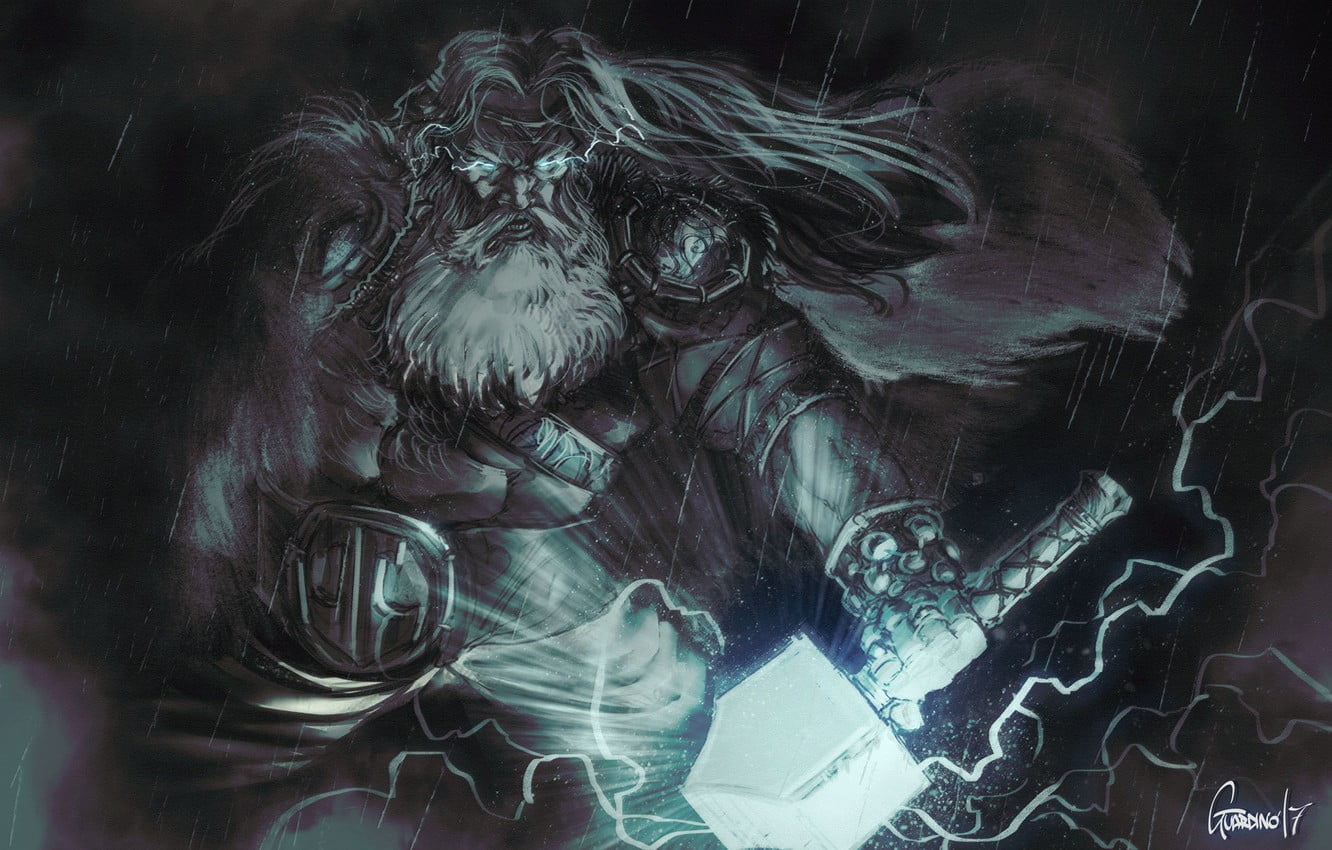
10 Facts About Thor
There is a lot to say about Thor, so here we will highlight the most interesting and important Thor Viking god facts.
- The red-haired man, whom the folk epic has endowed with almost all the features that are inherent in the strongest, most famous, and revered heroes. His name reflects his essence – Thunder. That is how it is translated from the Germanic language. Thor’s mother was the giantess Jord – the Earth Goddess, wife of Odin. The father of the god Thor was Odin himself. His wife was the golden-haired goddess Sif.
- Energetic man, lord of thunder and lightning, riding a huge chariot of bronze. The driving force behind this chariot were two goats, Tangniostr and Tanngrisnir (one gnashing his teeth and the other creaking). There are some thoughts that Thor is the god of war.
- God was born during a great hurricane when the elements were raging, the peals of thunder could be heard and flashes of lightning could be seen. It was at this hour that the earth goddess Erd brought her son Thor into the world.
- The supreme god Odin was overjoyed at the birth of his son. In that hour there was no boy more beautiful or stronger than he. But only one thing overshadowed – Thor grew up too capricious and cocky. He was very fond of smashing everything he could get his naughty hands on.
- While Thor was still young, his faithful “babysitters” were two wolves Odin – Freki and Geary. They carried him in their teeth, protected him, and brought him to his father’s house.
- Thor considered the giants his greatest enemies. Ironically, he shared many of the traits of these mythical creatures. Loki, the god of fire and cunning, accompanied Thor in his endless struggle with the giants. An intelligent and cunning companion often helped the giant in his battles. Scandinavian mythology mentions two more companions: Tjalvi and Röskva, who became the eternal servants of the god.
- Thor’s main task, of course, was to protect the gods and men from the True Giants, the Jotuns. Later Scandinavian tales and legends endowed him with the ability to protect the world from any dark forces.
- One day, the giant decided to pretend to be a builder to build a wall around the entire Asgard. If he could do it in time, he would take the sun, the moon, and Freya. The gods did not like this bet. They turned to Loki for help. He turns into a stallion and distracts the giant’s mare, who was helping him with the construction. Without her, he could not build the wall in time. Having lost the bet, the giant becomes enraged. That is when he is seen by Thor, who has just returned from a campaign.
- The red-haired god and the giant Hümir go fishing. But instead of good fish, they catch the serpent Jormungand. A fight ensues, but the creeper tears the rope and swims away.
- According to the legends, Thor could not prevent Ragnarök (the destruction of the whole world), but he managed to deal with the representative of eternal evil, the spawn of Loki, the serpent Jermungand. Thor himself dies from his poison, which gushes forth like a river from his severed head. The hammer of the god, however, was inherited by his son Magni.
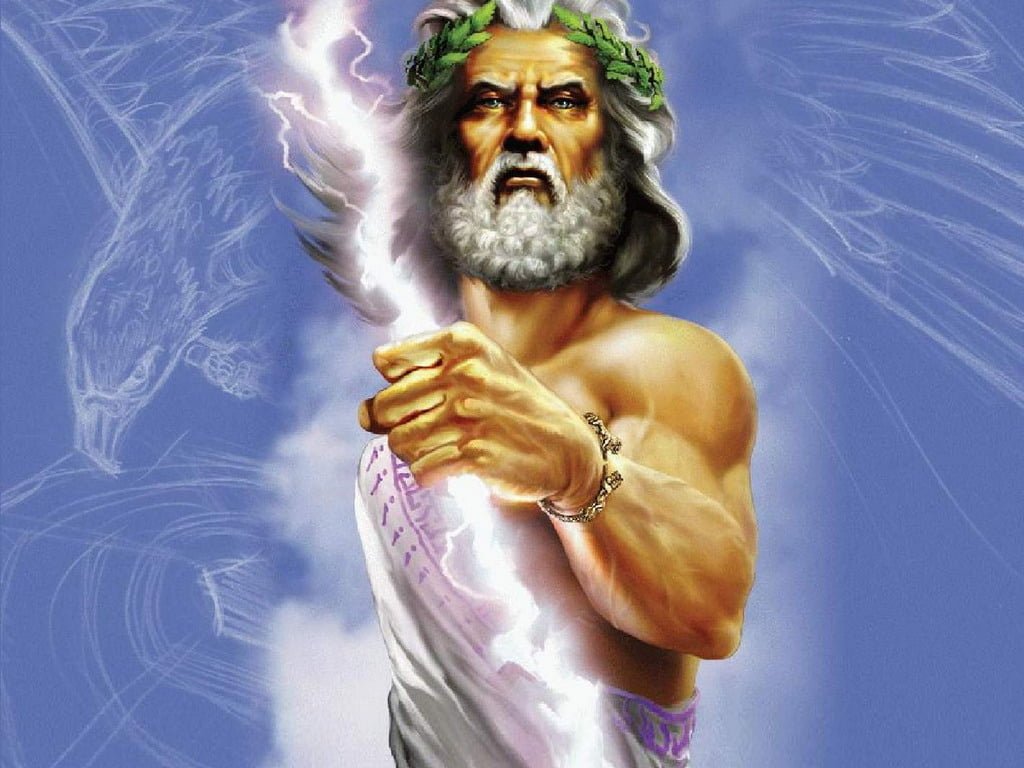
Greek God Equivalent Of Thor
Like the Greeks, the Nordic peoples believed that all things arise from chaos. While the Greeks imagined chaos as a nebulous formless mass, the Scandinavians, influenced by the surrounding nature, imagined chaos as fire and ice. This combination will be understandable to those who have ever been to Iceland and seen the stark contrast between the volcanic soil, the erupting geysers, and the huge icebergs that surround it in winter.
The Greek god Jupiter is very similar to Thor. We can’t say that Thor Greek god, because he isn’t considered in their culture.
The Scandinavian thunder god Thor shares many features with Jupiter. He is armed with the hammer Mjöllnir, the symbol of lightning among Northerners, and, like Jupiter, uses the hammer in the battle against the giants. Like Mercury, Thor matures very quickly: while the Scandinavian god, a few hours old, playfully tosses up several bales of bearskins, Mercury, when he is not yet a year old, steals Apollo’s bulls.
In his physical strength, Thor is comparable to Hercules, who at an early age also exhibited miracles of strength, strangling snakes in his cradle and then happily battling giants and monsters. Hercules disguised himself as a woman and sat at the spinning wheel to please Omphale, queen of Lydia, while Thor disguised himself as the goddess Freya to take his hammer from the giant Tryum. Thor’s main attribute, the hammer, was used by ancient Scandinavians for various purposes. The hammer was used to sanctify the funeral pyre and marriage ceremonies, and boundary poles driven by the hammer were considered sacred by the Norse, as were Hermes or statues of Hermes (Mercury), which could not be moved under pain of death.
Differences Between Thor And Zeus
There are many differences between Slavic and Scandinavian mythology, but the most interesting difference is the location of the thunder god, who in all Indo-European peoples is at the head of the pantheon, but if the Slavs god Zeus takes the leading place in the pantheon, Thor Norse god takes only second place, yielding the primacy to the war god Odin.
Scandinavian Thor is often compared with Zeus the Thunderer, the Slavic fire god Perun, Svarog, and other representatives of ancient world religions. They all share common features: they were seen as protectors of people, defenders, and guards who guard the border between the worlds. There is an opinion that Thor, like his father Odin, has very real prototypes from the world of living people. This theory was held by Thor Heyerdahl. His pen is a book about the Scandinavian epic “The Hunt for Odin. In the Footsteps of our Ancestors.
Many researchers believe that the Scandinavian epos and Slavic ancient legends tell about the same mythical creatures and gods. Scandinavian legends have much in common with Slavic legends. With the Slavs, for example, Thor was considered the main God who had three sons: Odin, Ving, and Star. There is even an assumption that the Slavs and Scandinavians are the same people who settled all over Europe.
If you look at the topic of Zeus vs Thor in detail. However, there is no big difference between them as such. Just they represent different peoples, a little different custom, by their nature they are very similar to each other.
You can even find Zeus vs Thor lyrics.
Who Was The God Of Strength And Son Of Thor?
The god of the Aesir family is Magni, the god of Scandinavian mythology.
According to legend, Magni was the son of the god Thor and the giantess Jarnsaka. When Magni was three nights old, he saved his father. After Thor’s duel with Hrungnir, when the giant’s leg crushed the god, the boy easily helped him free himself.
Since Jarnsaka was not Thor’s lawful wife, the boy had to be led into the clan to confirm his belonging to the Aesir. The feast took place at the house of Aegir, the master of the underwater wards. Magni was inducted into the clan and from then on frequently accompanied Thor on his journeys.
On the day of Ragnarok Magni is destined to wield Thor’s hammer. According to some versions of the myth, after Ragnarök he, along with the rest of the young gods, will create a new world.
Actor Who Plays Thor
Chris Hemsworth is a guy who plays Thor in the movies.
He is a Hollywood actor of Australian descent. Chris’s popularity came from his role as Thor in the Marvel Cinematic Universe, in which he appeared in solo films about the character and in blockbuster crossover films about the superhero team “The Avengers,” which includes Thor.
It should also be remembered that the role of Thor God of thunder movie belonged to Bucky Lucas, who played Thor in that old Viking movie.

